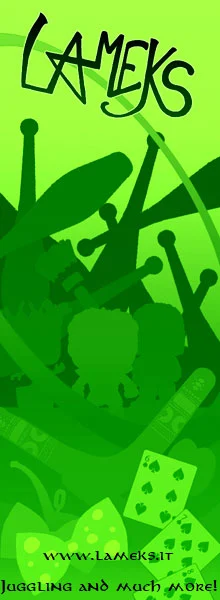Cito un paragrafo del libro
"The Mathematics of Juggling" scritto da
Burkard Polster.
Nel paragrafo 7.4.3 spiega l'antipallina, se qualche anima pia lo vuoi tradurre e spiegare anche a noi, non farebbe un soldo di danno.
 7.4.3 Antiballs, Antithrows, and Causal Diagrams
7.4.3 Antiballs, Antithrows, and Causal Diagrams
In the last subsection, we convinced ourselves that certain irrational numbers can be juggled. In the following, we describe two different ways in which negative throws can be incorporated into simple juggling sequences in a consistent manner. We call these two different ways ball/antiball juggling and throw/antithrow juggling. Again, these ideas first popped up on the newsgroup rec.juggling. Note that in some articles the two notions are presented as being identical, which is not correct; see, for example, Andrew Conway’s hilarious fictitious report on “high energy juggling” in which this mixing of different notions is (probably) intended to add to the humor and to trick the unwary reader.
Ball/Antiball Juggling
To juggle a negative throw in ball/antiball juggling, you need a special ball, called an antiball. When thrown, an antiball travels back in time. If an antiball comes in contact with an ordinary ball, the two balls annihilate each other. On the other hand, a ball/antiball pair can materialize out of thin air.
We now consider finite sequences of integers (not necessarily nonnegative) and try to interpret them in the usual manner as sequences of commands for juggling. Figure 7.15 shows the juggling diagram that corresponds to the sequence 25–1–130; that is, 2, 5, −1, −1, 3, 0. Note that, as before, a positive integer i under a beat says that a ball is being thrown to height i and a 0 says that nothing happens. A negative integer i means that beats in the future. We draw the trajectories of balls right side up and those of antiballs upside down. We call the sequence we started with a ball/antiball juggling sequence if and only if on every beat exactly one of the following happens:
• Nothing happens.
• One ball gets caught and thrown.
• One antiball gets caught and thrown.
• One antiball gets caught, one ball gets caught, and both vanish.
• One antiball and one ball materialize out of thin air and both are thrown.
Check that this is really what happens in Figure 7.15. In particular, we see two beats on which a ball and an antiball collide and vanish. There are also two beats on which a ball/antiball pair materializes.
FIGURE 7.15. The juggling diagram of the ball/antiball juggling sequence 25–1–130.
This definition extends our usual notion of a simple juggling sequence in a consistent manner; that is, every simple juggling sequence is a ball/antiball juggling sequence. However, on closer inspection, it turns out that we do not really get anything new. Given any simple juggling sequence, we can replace any of its elements i by −i to arrive at a ball/antiball juggling sequence. For example, in 251130 we can replace the two 1s by −1s to arrive at our example above. In the juggling diagram, this amounts to reflecting the corresponding arcs at the beat line. On the other hand, every ball/antiball juggling sequence clearly arises in this manner.
Throw/Antithrow Juggling
In throw/antithrow juggling, we make a negative throw by throwing an ordinary ball back in time.
Again, we consider finite sequences of integers and interpret them very much like in the case of ball/antiball juggling (juggling diagram and all) except that a negative number i in a sequence means that on the corresponding beat a ball is thrown −i beats into the past.
We call a sequence of integers a throw/antithrow juggling sequence if and only if, as in the case of simple juggling sequences, at most one ball gets caught and thrown on every beat and, if one is caught, it is immediately thrown again. This definition also extends our usual notion of a simple juggling sequence in a consistent manner, and this time we do get something essentially new and interesting. Figure 7.16 shows the juggling diagrams for a number of fun throw/antithrow sequences.
FIGURE 7.16. Juggling diagrams of the four throw/antithrow juggling sequences
1–1, 50–2, 333–3–3–3, and 5–1–1–1–1–1.
You can check for yourself that virtually every result about simple juggling sequences has an extension to a result about throw/antithrow sequences.
Here are a few examples:
• Permutation Test. A finite sequence of integers s is a throw/antithrow juggling sequence if and only if its associated function φs is a permutation; see page 22 for a definition of the function φs. Also, in Section 2.4 we showed that simple juggling sequences correspond to special periodic permutations of the integers. It is easy to see that this correspondence extends naturally to a one-to-one correspondence
between the set of all throw/antithrow juggling sequences and the set of all periodic permutations of the integers.
• Average Theorem. We are juggling a throw/antithrow juggling sequence. Sometime in between two beats, we count the number of balls in the air such that a ball that travels forwards or backwards in time is counted as 1 ball or −1 ball, respectively. Then, the total number of balls in the air is the average of the elements in the sequence.
• Site Swaps. Site swaps turn throw/antithrow juggling sequences into throw/antithrow juggling sequences. More generally, we can apply any of the operations collected in Section 3.5 to throw/antithrow juggling sequences to construct new such sequences.
It is also clear that the negative of every throw/antithrow juggling sequence is a throw/antithrow juggling sequence and that the simple juggling sequences are exactly the throw/antithrow juggling sequences all of whose elements are nonnegative.
Spero di non aver fatto nulla di illegale...












